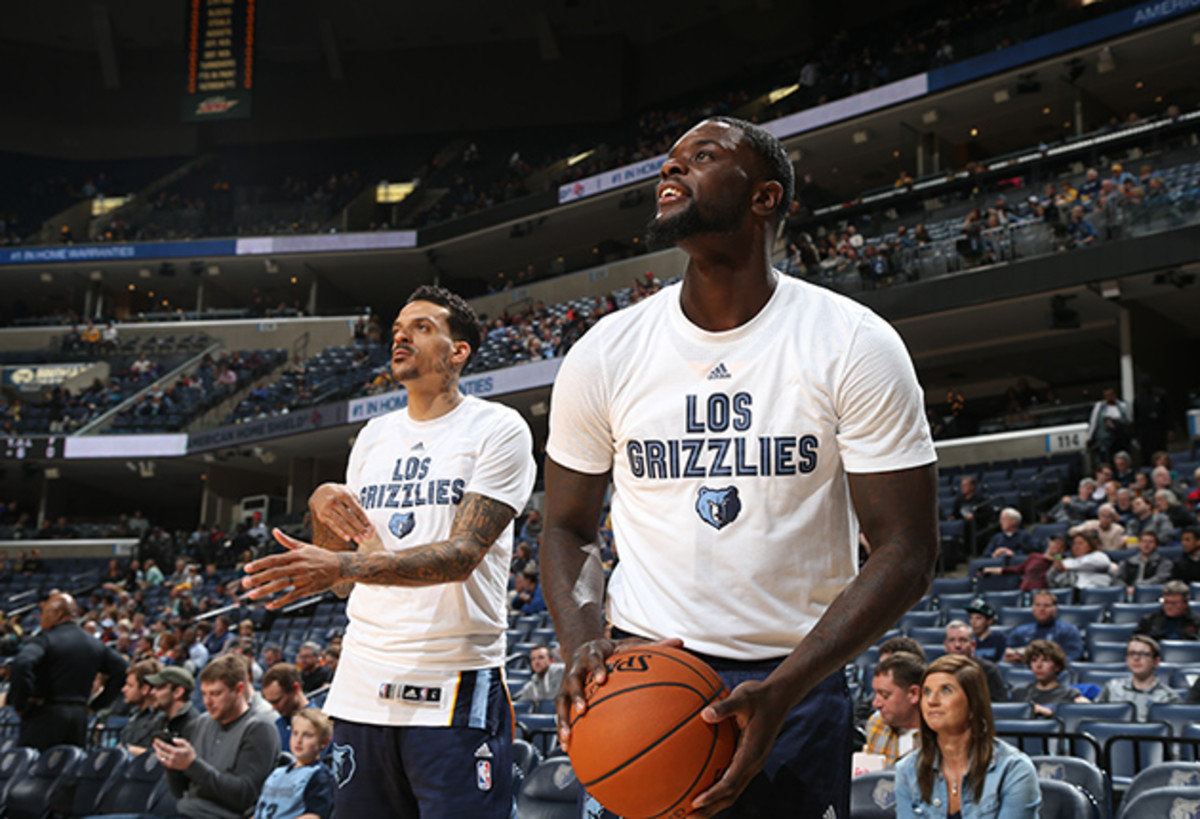Overachievement woven into the Grizzlies’ fabric

When a painful right-foot fracture ended Marc Gasol’s season, the Memphis Grizzlies had no choice but to drift off-center. The league is short on plug-and-play reserves who could match Gasol’s wide array of skills. Memphis, to complicate matters, was short on plug-and-play reserves who could even step in to fill minutes at all; Zach Randolph started at the five in the Grizzlies’ first game after the fact virtually by default. The only other listed center on the roster was 10-day contract signee Ryan Hollins and moving Randolph from the four to the five only created a new void at power forward. Memphis went on to win that first Gasol-less game by 19 points.
To the point: Giannis Antetokounmpo blossoming with the ball
The weeks since have somehow brought more injuries and more victories in Memphis. Monday’s 106–103 win over the Cavaliers—in which the Grizz went without Gasol, Randolph, Mike Conley, Matt Barnes, Brandan Wright, and Chris Andersen—marks their most ridiculous overreach yet. A true championship contender buckled under 26 points from Tony Allen, the stylings of JaMychal Green, and a hard-played game from reserves masquerading as starters. The Grizzlies haven’t been an elite team this season and surely aren’t one now. But damned if they haven’t been spirited and resourceful in winning nine of their 12 games since Gasol bowed out.
Overachievement is woven into the fabric in Memphis. For four straight seasons the Grizzlies have outperformed their expected record (based on actual performance, not preseason expectation) by two games or more. As of today, they’re currently seven wins ahead of the 31–32 mark their overall play would suggest, according to pythagorean projections. Even the fully healthy Grizzlies bore the statistical markers of a .500 team. That they’ve clawed to 38 already makes them a virtual lock for the playoffs regardless of Gasol’s absence and their increasingly difficult schedule.
Even a few games’ difference could have brought Memphis’ playoff hopes to real peril. Instead, the Grizzlies have largely taken care of inferior teams while springing for the occasional win that seems well out of their league—Monday’s display a case in point. Conley (17.8 points on 48.1% shooting with 6.1 assists since Gasol’s injury) had been spectacular, though Mario Chalmers, too, filled in for him ably. Randolph (17 points on 47.8% shooting, 6.8 rebounds) has held down the fort as best he can, though Green has become an essential part of the Grizzlies best makeshift lineups. Barnes’ ability to credibly battle opposing power forwards has been critical to Memphis’ structural integrity. Vince Carter dusted off his jumper to resume regular rotation duty. Lance Stephenson, human hot dog, is looking more dynamic than in Los Angeles and Charlotte, if equally foolish at times.
• MORE NBA: 100 greatest moments in sports history | Warriors outtakes

That said, none of the above quite makes 9–3 sense—which is part of what makes the Grizzlies great. Some of the lineups that coach Dave Joerger is all but forced to field seem as though they might never score. Others appear as though their coverage should fold at any moment. Memphis just has a way of making things happen that goes far beyond what could reasonably be expected. It starts with effort, as to a man the Grizzlies are working their asses off to make basketball ends meet. Even successful offensive possessions often take a lot of legwork; although Memphis is taking about four more three-pointers per game since Gasol’s injury, opponents still tend to muck up the works by taking a more relaxed approach on the perimeter.
Conley had been able to orchestrate in spite of that, while the Grizzlies overall have done a stellar job of creating shots without turnover. Those shots aren’t always high-value looks (as tends to happen when second- and third-string players are thrust into prominent roles) in themselves, though the aggregate value of keeping the ball secure has helped Memphis squeeze the most out of its offensive possessions.
• OPEN FLOOR WITH LEE JENKINS: Jamal Crawford | Meyers Leonard
Contrast that security with the way the Grizzlies force turnovers and a winning margin begins to take shape. Allen and Chalmers are ruthless ball hawks, eager to prey on any pass or dribble made casually. Conley balances their aggressive style by applying smart, selective pressure—the kind that risks little but doesn’t let opponents off easy. Those three will spend more time playing as a perimeter unit as the Grizzlies get healthier, though Chalmers and Allen will start in the interim to contest opponents from minute one. Behind them is a collection of active defenders ready to seize opportunities. They might not rack up steals, per se, but Green has great hands for a big and even the 39-year-old Carter manages to get the jump on opponents with preemptive defense.
In all, the sans-Gasol Grizzlies have turned opponents over on 18.5% of their possessions while committing a turnover on just 12.8% of their own, per NBA.com. That is a crazy, unsustainable margin that will close slightly as Memphis plays better opponents. For now, however, it works. This is a team that still gets to the free throw line in spite of its lack of creators, has kept competitive on the boards with a considerably undersized frontcourt, and somehow managed to survive an outmatched first unit to win games with depth. These are likely the twilight months of grit and grind, an era of Memphis basketball that will soon meet its unavoidable end. How fitting, then, that the Grizzlies as we’ve known them—and even some that are donning the uniform for the first time—embody a different brand of the same, essential defiance.
